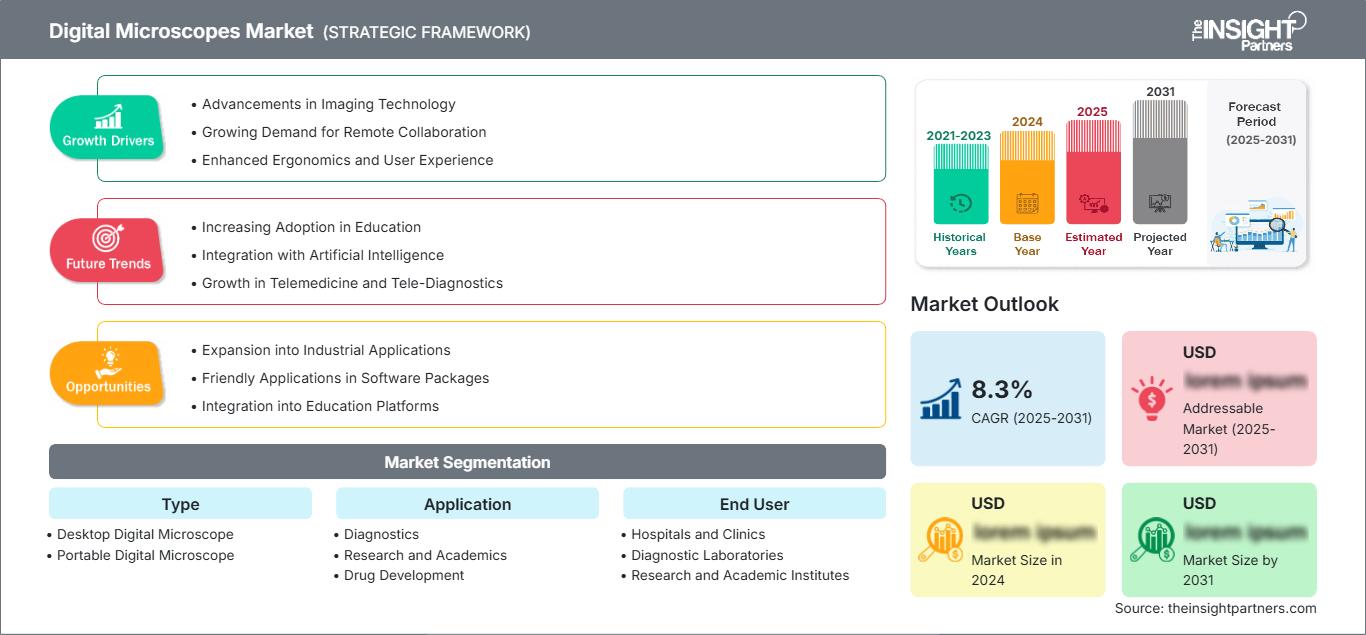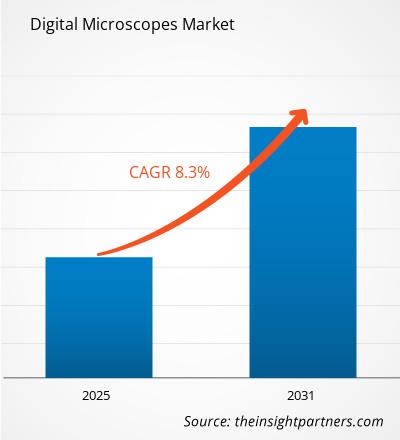The Digital Microscopes Market is expected to register a CAGR of 8.3% from 2025 to 2031, with a market size expanding from US$ XX million in 2024 to US$ XX Million by 2031.
The report is segmented ByType (Desktop Digital Microscope, Portable Digital Microscope); Application (Diagnostics, Research and Academics, Drug Development); End User (Hospitals and Clinics, Diagnostic Laboratories, Research and Academic Institutes, Pharmaceutical and Biotechnological Companies). The global analysis is further broken-down at regional level and major countries. The Report Offers the Value in USD for the above analysis and segments.
Purpose of the Report
The report Digital Microscopes Market by The Insight Partners aims to describe the present landscape and future growth, top driving factors, challenges, and opportunities. This will provide insights to various business stakeholders, such as:
- Technology Providers/Manufacturers: To understand the evolving market dynamics and know the potential growth opportunities, enabling them to make informed strategic decisions.
- Investors: To conduct a comprehensive trend analysis regarding the market growth rate, market financial projections, and opportunities that exist across the value chain.
- Regulatory bodies: To regulate policies and police activities in the market with the aim of minimizing abuse, preserving investor trust and confidence, and upholding the integrity and stability of the market.
Digital Microscopes Market Segmentation
Type
- Desktop Digital Microscope
- Portable Digital Microscope
Application
- Diagnostics
- Research and Academics
- Drug Development
End User
- Hospitals and Clinics
- Diagnostic Laboratories
- Research and Academic Institutes
- Pharmaceutical and Biotechnological Companies
Geography
- North America
- Europe
- Asia-Pacific
- South and Central America
- Middle East and Africa
You will get customization on any report - free of charge - including parts of this report, or country-level analysis, Excel Data pack, as well as avail great offers and discounts for start-ups & universities
Digital Microscopes Market: Strategic Insights

- Get Top Key Market Trends of this report.This FREE sample will include data analysis, ranging from market trends to estimates and forecasts.
Digital Microscopes Market Growth Drivers
- Advancements in Imaging Technology: Advances in imaging technology have been a significant growth factor for the digital microscope market. New technologies, including high-resolution digital cameras and better software capabilities, allow more vivid, high-resolution images to be created. Improved imaging capability has allowed researchers and professionals in biology and materials science, to name just a few, to complete more accurate analyses than ever before. This has also made digital microscopes even more appealing options for use in laboratories and educational institutions.
- Growing Demand for Remote Collaboration: Another significant driver of the demand for digital microscopes is the increasing demand for remote collaboration from both the research and education realms. With a digital microscope, people can share real-time images and data over the Internet, which facilitates collaboration among teams despite their location. This is of immense value in academics as well as in all research institutions, where one can hasten the research process by sharing findings and insights quickly.
- Enhanced Ergonomics and User Experience: This tends to drive the growth of the market. Traditional microscopes cause straining over long periods, but this is not the same with digital ones; they lack eyepieces, and samples are visualized on screens. This design offers comfort, while users with all types of experience find it easy to use, thus making digital microscopes appealing both in learning and professional environments.
Digital Microscopes Market Future Trends
- Increasing Adoption in Education: Increasing adoption in the education sector is one of the glaring trends in which digital microscopes are used mainly in educational fields. Schools and universities focus on learning-by-doing and collaborative teaching methods. Hence, digital microscopes keep engaging students in microscopic worlds through their ability to connect with computers and display images, thus collaborating learning.
- Integration with Artificial Intelligence: The market is changing due to artificial intelligence being incorporated into digital microscopes. AI-powered feature, including automated image analysis and pattern recognition, helps a researcher analyze data in a much more streamlined manner than would have had to if the computer carried out such tasks; this, therefore, allows researchers to focus on critical analyses instead of laborious processing of data by hand, thus increasing the demand for advanced digital microscopes.
- Growth in Telemedicine and Tele-Diagnostics: The growth of telemedicine and tele-diagnostics is majorly driving the digital microscope market. As the usage of remote consultations by healthcare providers increases, high-definition imaging-equipped digital microscopes combined with sharing real-time microscopic images with experts enable effective diagnostics and care of patients, especially in underserved regions. It has thus created new markets for the manufacturing of digital microscopes.
Digital Microscopes Market Opportunities
- Expansion into Industrial Applications: Apart from quality control and inspection, industrial applications hold much scope not only across various industries but also into other fields. For instance, through digital microscopes, image resolutions are improved in different domains of manufacturing and electronics. Businesses that employ this specific technology will enhance the quality of their products, making fewer mistakes, and consequently, they can increase the demand for digital microscopy solutions in industrial applications.
- Friendly Applications in Software Packages: Companies can develop many other friendly software applications from digital microscopes. A number of researchers and educators require simplified tools for data analysis and image processing. This will help in simpler processes or data and image analyses, respectively, thus reducing complications associated with these processes and consequently improving the user experience. It would include it in the target market as a potential customer for produced goods and expand market clientele with minimum technical capabilities if its focus involves accessible and user-friendly software solutions.
- Integration into Education Platforms: Since digital microscopes are based on innovation, integrating them into education sites will induce mass growth in the market. For example, they can easily incorporate virtual resources that are meant for distance learning. This makes science education interactive and exciting, thereby making it compulsory in classrooms all over the world. This also creates another portal for sales and partnerships in the education sector.
Digital Microscopes Market Regional Insights
The regional trends and factors influencing the Digital Microscopes Market throughout the forecast period have been thoroughly explained by the analysts at The Insight Partners. This section also discusses Digital Microscopes Market segments and geography across North America, Europe, Asia Pacific, Middle East and Africa, and South and Central America.
Digital Microscopes Market Report Scope
| Report Attribute | Details |
|---|---|
| Market size in 2024 | US$ XX million |
| Market Size by 2031 | US$ XX Million |
| Global CAGR (2025 - 2031) | 8.3% |
| Historical Data | 2021-2023 |
| Forecast period | 2025-2031 |
| Segments Covered |
By Type
|
| Regions and Countries Covered | North America
|
| Market leaders and key company profiles |
|
Digital Microscopes Market Players Density: Understanding Its Impact on Business Dynamics
The Digital Microscopes Market is growing rapidly, driven by increasing end-user demand due to factors such as evolving consumer preferences, technological advancements, and greater awareness of the product's benefits. As demand rises, businesses are expanding their offerings, innovating to meet consumer needs, and capitalizing on emerging trends, which further fuels market growth.

- Get the Digital Microscopes Market top key players overview
Key Selling Points
- Comprehensive Coverage: The report comprehensively covers the analysis of products, services, types, and end users of the Digital Microscopes Market, providing a holistic landscape.
- Expert Analysis: The report is compiled based on the in-depth understanding of industry experts and analysts.
- Up-to-date Information: The report assures business relevance due to its coverage of recent information and data trends.
- Customization Options: This report can be customized to cater to specific client requirements and suit the business strategies aptly.
The research report on the Digital Microscopes Market can, therefore, help spearhead the trail of decoding and understanding the industry scenario and growth prospects. Although there can be a few valid concerns, the overall benefits of this report tend to outweigh the disadvantages.
Frequently Asked Questions
Who are the prominent players in Digital Microscopes Market ?
At what CAGR theDigital Microscopes Market projected to grow?
Major driver boosting theDigital Microscopes Market growth?
Which is the fastest growing region inDigital Microscopes Market ?
Which region accounts for highest revenue shareDigital Microscopes Market ?
What years does thisDigital Microscopes Market ?
/
country-wise market wherein 2021-2022 are the historic years, 2023 is considered to be the base year, and the forecast will be provided till 2031, along with CAGR (%)
- Historical Analysis (2 Years), Base Year, Forecast (7 Years) with CAGR
- PEST and SWOT Analysis
- Market Size Value / Volume - Global, Regional, Country
- Industry and Competitive Landscape
- Excel Dataset
Recent Reports
Related Reports
Testimonials
Reason to Buy
- Informed Decision-Making
- Understanding Market Dynamics
- Competitive Analysis
- Identifying Emerging Markets
- Customer Insights
- Market Forecasts
- Risk Mitigation
- Boosting Operational Efficiency
- Strategic Planning
- Investment Justification
- Tracking Industry Innovations
- Aligning with Regulatory Trends





















 Get Free Sample For
Get Free Sample For